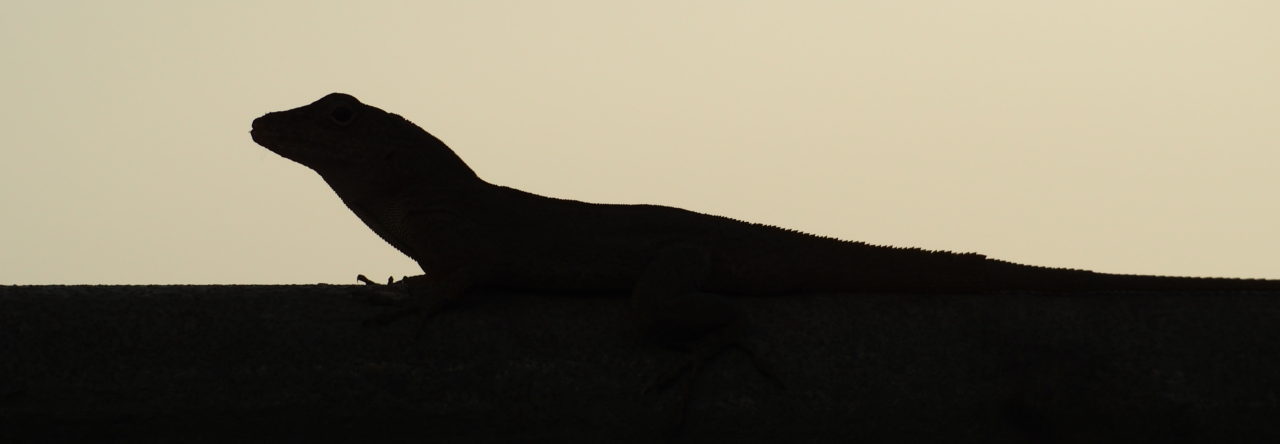
This particular lizard did not show much fear towards our plastic snake. Photo credit: Bjorn Briesen
And now for something completely different … lacertid lizards. It almost feels like I am releasing an invasive species within Anole Annals, but dr. Jonathan Losos nevertheless kindly asked me to write something about our recent paper on the effect of insularity and urbanization on the foraging decisions of the Dalmatian Wall lizard (Podarcis melisellensis), stating that “Lacertids are honorary Anoles.”
The Functional Morphology Lab of the University of Antwerp has a long-standing tradition of research on the Croatian islands. Once a year, several members of our team travel to Croatia, accompanied by a bunch of students in the context of a course on Island Biology. In fact, four out of six collaborators on our paper (including me) were still undergraduate students when conducting the fieldwork. We soon came up with the idea to compare risk-taking and reaction to novelty of wall lizards during foraging in both urban and insular environments. Strange choice? Not at all. Both urban and insular habitats are characterized by reduced levels of predation, but also a lack of resources (e.g. lower abundance and diversity of arthropod prey). Such conditions should prompt both insular and urban lizards to behave bolder during foraging, and act less neophobic, since the risk of predation is low, but the value of the food reward is high. Fortunately, the Croatian islands are perfect to test these kind of hypotheses. Sampling both rural and urban areas on the larger island of Vis was a piece of cake, especially since wall lizards can easily be found in the harbour of Vis.

Believe it or not, wall lizards can easily be found in the harbour of vis. Photo credit: Gilles De Meester
Vis itself is surrounded by many small islets, most of them inhabited by dense populations of lizards. Some of these islets, like Biševo and Veli Budikovac, are (semi-)inhabited. Others, like Brusnik, are completely devoid of any human activity. So, small islets? Check. Urban and rural areas? Check. What else was needed? A predator model to test risk-taking, and a novel object to test neophobia. After a few pilot trails in which we compared the response of lizards to a plastic snake model and a stuffed rook (Corvus frugilegus), it was clear that lizards showed more fear of the snake. Our novel object was randomly chosen to be a flashy red drinking bottle.
Lizards from smaller islets did indeed take more risks while foraging compared to lizards from the main island. Islet lizards were more likely to leave a safe refuge in order to get a tasty mealworm, despite the presence of the snake model, and also on average left their refuges faster to do so. In fact, on multiple occasions, lizards did completely ignore the snake model, even running over it to get to the petri dish with food.

Another example of a very bold lizard. Photo credit: Bjorn Briesen.
But even on the main island of Vis, lizards behaved very boldly. In fact, between observations, we were often capable of hand-feeding some wild individuals. On the island of Brusnik, a few lizards showed absolutely no fear at all of humans, even licking and biting our hands when we came close to remove the petri dish at the end of a trail. This is, of course, a very nice illustration of the phenomenon known as “island tameness.” Due to a lower number of predators on islands and islets, insular species often lack normal antipredator behaviour, something that even Darwin already reported after his famous voyage on the Beagle. Unfortunately, this tameness is the main reason for the historical decline and extinction of many insular species, especially after humans started bringing new predators (rats and cats) to these islands.

Maybe he was just thirsty? Photo credit: Gilles De Meester
Neophobia, whether the lizards were willing to feed in front of a novel object, did not differ between main island and small islets, despite the assumption that islet lizards should behave less neophobically as they will benefit more from exploiting new resources. In fairness, lizards overall seemed to lack a neophobic reaction towards the novel object, as they did not differ in feeding latencies from the control group. Interestingly, however, in Brusnik, lizards behaved very neophilically towards the drinking bottle. Some individuals even completely ignored the offered food in favour of this novel object.
Surprisingly, lizard behaviour did not differ between urban and rural environments. While numerous papers have proven that urban birds and mammals behave more boldly and less neophobically compared to their rural conspecifics, the few studies on reptiles have yielded mixed results. In fact, it is still unclear whether lizards do indeed experience lower predation risk in urban areas. While natural predators might be rare, they are often replaced by dogs, rats or cats (and we all know that cats are the killing machines of nature). We did indeed observe predation on wall lizards in the harbour of Vis, not by a cat, but by a hooded crow (Corvus cornix). A strong argument can be made that urban habitats are more open, leaving foraging lizards at greater risk of being seen by predators.
More detailed studies of behaviour of urban lizards, together with estimations of resource availability and predation pressure, could help us understand why lizards seemingly adapt different to urban environments compared to mammals or birds.
More detailed interpretation of our results, complete with nice graphs and interesting p-values, can be found in our published paper.
















